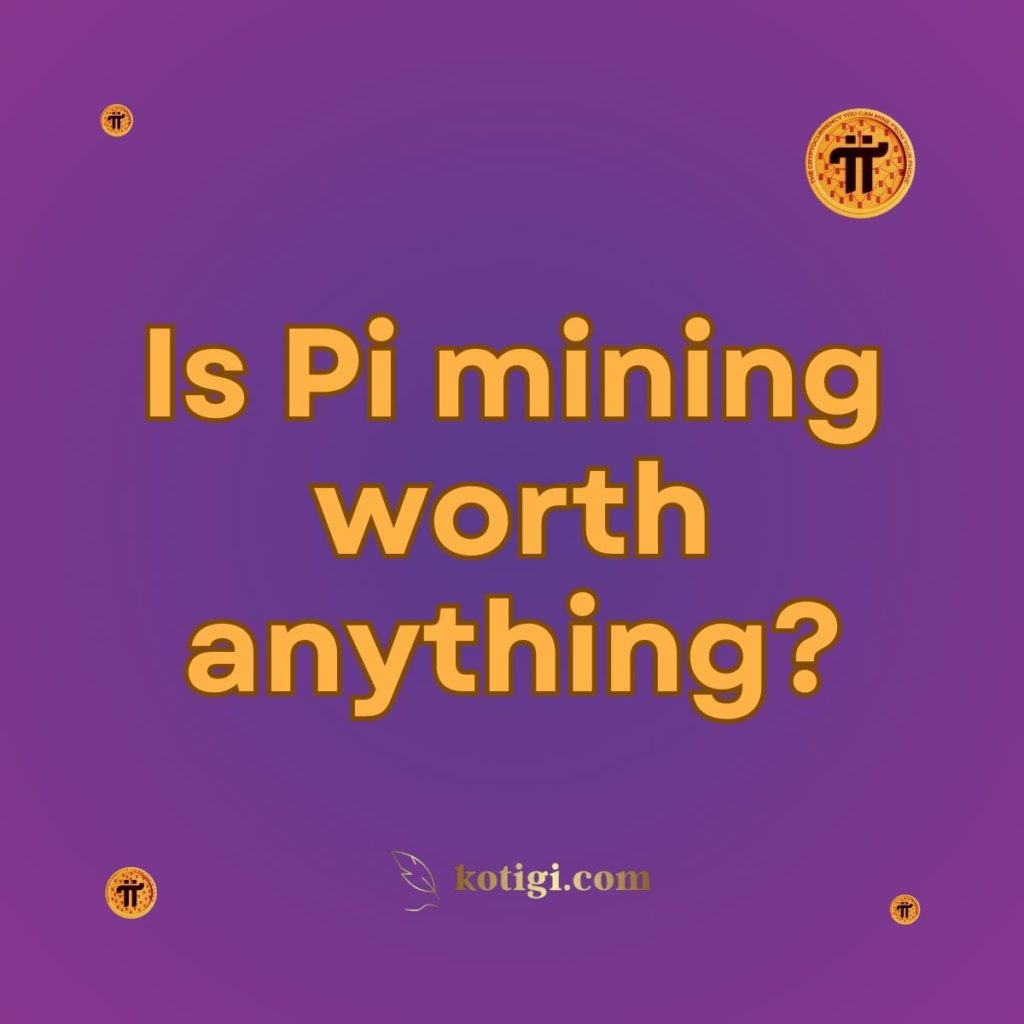
Cryptocurrency mining has become a lucrative venture for many, with Bitcoin and Ethereum leading the charge. However, the Pi Network offers a unique approach to mining: it allows users to mine Pi on their smartphones without draining resources. This raises a big question: is Pi mining worth anything? While the app has garnered millions of users, the true value of Pi remains uncertain, making many wonder if their mining efforts will pay off. In this blog post, we’ll explore the worth of Pi mining by delving into how it works, its current value, and what the future might hold.
What is Pi Mining?
Understanding the Pi Network
The Pi Network, launched by a group of Stanford graduates, is a decentralized cryptocurrency project aiming to create a globally accessible digital currency. Pi operates differently from traditional cryptocurrencies like Bitcoin, which rely on resource-heavy Proof-of-Work (PoW) mechanisms. Instead, Pi uses a consensus algorithm based on the Stellar Consensus Protocol (SCP).
Mining Pi is simple: all you need is a smartphone and the Pi app, which allows users to mine coins without consuming substantial energy or data. This makes Pi accessible to the average person, making it stand out from the more complicated, resource-heavy mining setups of Bitcoin or Ethereum.
How Pi Mining Differs from Traditional Cryptocurrency Mining
One of the standout features of Pi mining is that it doesn’t involve the use of high-powered computers or specialized hardware. Unlike Bitcoin, where miners solve complex mathematical problems to validate transactions, Pi relies on a user-based network to secure its blockchain.
Mining Pi doesn’t drain battery life or data since it’s a lightweight process. This makes it user-friendly and eco-conscious. Instead of focusing on hashing power, Pi encourages users to build trust circles by inviting others to join the network, creating a layered system of security.
The Current Value of Pi
Pi’s Value in the Market (or Lack Thereof)
As of now, Pi has no tangible market value. It’s not listed on major cryptocurrency exchanges like Binance, Coinbase, or Kraken. This has led to skepticism, with many asking: if it can’t be traded, does it have any value?
The Pi Network is currently in its testing phase (Testnet), which means Pi coins mined by users are not yet tradable on the open market. Some enthusiasts hold onto the belief that once the project transitions to its mainnet (the full version of the blockchain), Pi will be listed and gain monetary value. However, until that happens, Pi coins essentially exist as units on the app, with no real-world worth.
Potential Future Value of Pi
Despite its lack of current value, many users are optimistic about Pi’s future. The core team has emphasized that Pi’s value will come from its utility and community. When the network launches its mainnet and developers build decentralized apps (DApps) on top of the Pi blockchain, Pi could be used in real-world transactions, giving it value.
Additionally, if Pi is listed on major exchanges, it would allow holders to trade it for other cryptocurrencies or fiat money, potentially increasing its value. The growing community behind the project is also seen as a major driver of potential demand.
Factors That Could Affect Pi’s Future Value
The Role of Community Growth
Pi’s value is tied to its user base, which has grown significantly since its inception. With over 35 million engaged “Pioneers” (users), Pi’s future value may largely depend on continued community engagement and the network’s ability to grow. A large and active user base could create the demand necessary for Pi to gain value.
The network’s consensus algorithm also relies on trust circles, which incentivizes users to grow the community. A larger, more secure network can attract developers and businesses, possibly increasing Pi’s utility and perceived value.
Will Pi Get Listed on Major Exchanges?
A major question for anyone mining Pi is whether the coin will eventually be listed on exchanges. While there is no guarantee, the core team has expressed intentions to list Pi on exchanges once the project reaches the mainnet phase. For Pi to become tradable, it must meet certain regulatory and exchange requirements, which could take time.
Listing Pi on exchanges would make it easier to assign it a market value based on demand and supply dynamics. Once traded, the value of Pi could fluctuate just like other cryptocurrencies, allowing users to benefit from any potential price increases.
The Influence of Blockchain Adoption
Beyond its current hype, Pi’s long-term success may depend on its adoption within the blockchain ecosystem. If Pi can build a network of DApps that offer real-world applications, its value could grow. For example, if Pi were to be integrated into payment systems, online services, or decentralized finance (DeFi) applications, its use case would expand.
Pi’s blockchain needs to demonstrate a unique selling point that sets it apart from other projects. If it successfully integrates into the broader cryptocurrency landscape, it could gain legitimacy and value over time.
Is Pi Mining Worth the Time and Effort?
Low Barrier to Entry
One of the biggest advantages of Pi mining is that it requires minimal effort. Unlike Bitcoin mining, which requires expensive equipment and significant electricity costs, Pi mining can be done with a simple tap on your smartphone. There are no costs involved, making it a low-risk activity.
For many users, this low barrier to entry is appealing. Even if Pi never gains significant value, there’s little to lose from participating, as it doesn’t require any financial investment.
Opportunity Cost vs. Future Potential
While mining Pi might not cost money, it does take up time. Users need to open the app daily to ensure they keep mining Pi. Some might argue that the time spent could be used more productively, especially since there is no guaranteed return on investment.
However, for those willing to take a long-term view, the potential future rewards may outweigh the current opportunity costs. If Pi does gain value, early adopters could stand to benefit from having accumulated large amounts of Pi during its early stages. Ultimately, whether Pi mining is worth the effort depends on individual beliefs about the project’s future success.
Conclusion
At this point, Pi mining is a speculative venture. While it offers the advantage of being easy and cost-free, its current worth is negligible as it cannot be traded or exchanged for real-world assets. However, its future potential holds promise, especially if Pi is listed on exchanges and gains utility within a broader blockchain ecosystem.
For now, Pi mining might be worth your time if you’re optimistic about the project’s future and are willing to take a chance on its eventual value. With millions of users and a growing network, Pi could become a valuable asset in the future — but as with all cryptocurrencies, there’s no guarantee.
Mining Pi might not have tangible rewards yet, but for those who believe in the project’s potential, it could be a worthwhile gamble. Ultimately, only time will tell whether Pi mining will pay off.
Is Pi mining worth anything?
For now, Pi mining might be worth your time if you’re optimistic about the project’s future and are willing to take a chance on its eventual value. At this point, Pi mining is a speculative venture. While it offers the advantage of being easy and cost-free, its current worth is negligible as it cannot be traded or exchanged for real-world assets.
Takeaways
Here’s a list of key takeaways from the post:
- No current market value: Pi Network is not listed on any exchanges, meaning Pi coins cannot yet be traded or exchanged for money.
- Easy and cost-free mining: Pi mining is simple, requiring only a smartphone and minimal effort, with no significant energy consumption or cost.
- Speculative future value: Pi may gain value if it is listed on exchanges and if the network achieves utility within real-world applications and the blockchain ecosystem.
- Community growth is critical: The success and potential value of Pi rely heavily on its active and growing user base.
- Opportunity vs. effort: While Pi mining takes little effort, it remains speculative, and there is no guarantee of future returns.
- Potential high rewards for early adopters: Those mining Pi early could benefit if Pi gains value in the future, but this is uncertain.
- “Wait-and-see” approach: Pi mining is low-risk, but its worth will only become clear as the project develops and enters the mainnet phase.





